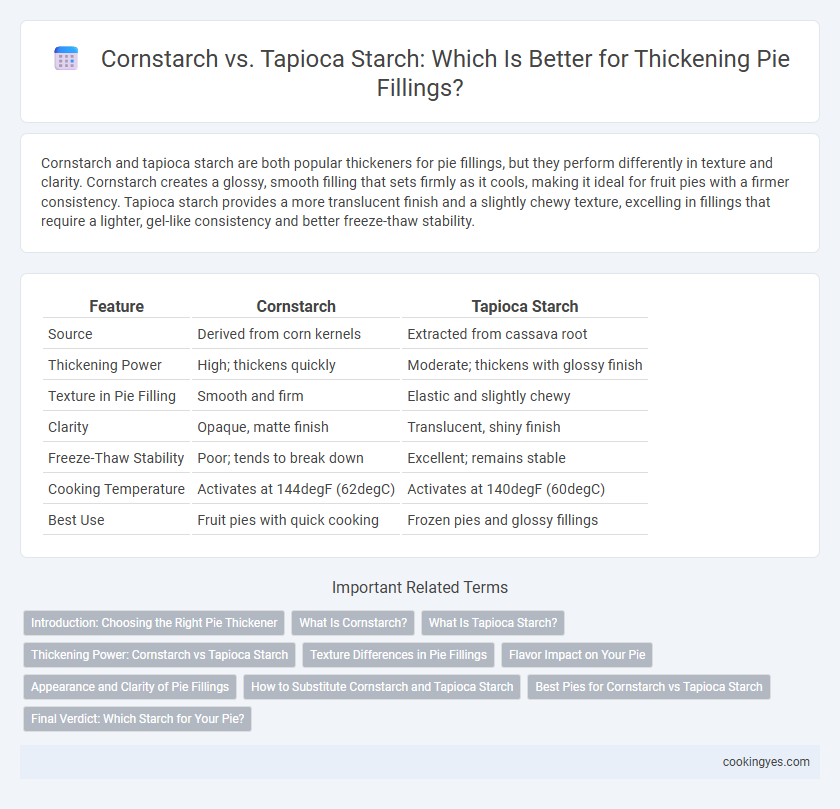Cornstarch and tapioca starch are both popular thickeners for pie fillings, but they perform differently in texture and clarity. Cornstarch creates a glossy, smooth filling that sets firmly as it cools, making it ideal for fruit pies with a firmer consistency. Tapioca starch provides a more translucent finish and a slightly chewy texture, excelling in fillings that require a lighter, gel-like consistency and better freeze-thaw stability.
Table of Comparison
| Feature | Cornstarch | Tapioca Starch |
|---|---|---|
| Source | Derived from corn kernels | Extracted from cassava root |
| Thickening Power | High; thickens quickly | Moderate; thickens with glossy finish |
| Texture in Pie Filling | Smooth and firm | Elastic and slightly chewy |
| Clarity | Opaque, matte finish | Translucent, shiny finish |
| Freeze-Thaw Stability | Poor; tends to break down | Excellent; remains stable |
| Cooking Temperature | Activates at 144degF (62degC) | Activates at 140degF (60degC) |
| Best Use | Fruit pies with quick cooking | Frozen pies and glossy fillings |
Introduction: Choosing the Right Pie Thickener
Cornstarch and tapioca starch are popular thickeners for pie filling, each offering distinct textures and clarity. Cornstarch creates a smooth, glossy finish ideal for fruit pies like cherry or blueberry, while tapioca starch provides a more translucent, gel-like consistency perfect for pies with juicy fillings such as apple or peach. Understanding their heat tolerance and thickening properties helps bakers achieve the desired pie texture and prevent filling weeping or separation.
What Is Cornstarch?
Cornstarch is a fine, white powder derived from the endosperm of corn kernels, widely used as a thickening agent in pie fillings due to its ability to create a glossy, translucent finish. It effectively thickens liquids by absorbing water and swelling when heated, making pie fillings smooth and stable without altering flavor. Compared to tapioca starch, cornstarch thickens faster and produces a firmer texture, ideal for classic fruit pies like apple or cherry.
What Is Tapioca Starch?
Tapioca starch, derived from the cassava root, is a gluten-free thickening agent commonly used in pie fillings for its clear, glossy finish and stable texture under freezing and reheating conditions. Unlike cornstarch, which can break down and become thin or cloudy when overcooked or frozen, tapioca starch maintains viscosity and a smooth consistency, making it ideal for fruit pies like cherry or blueberry. Its neutral flavor and superior thickening power also allow for less quantity usage while delivering a chewy, pleasant mouthfeel in the pie filling.
Thickening Power: Cornstarch vs Tapioca Starch
Cornstarch has a stronger thickening power than tapioca starch, requiring less quantity to achieve a thick and glossy pie filling. Tapioca starch provides a more flexible, slightly chewy texture and remains stable after freezing and thawing, making it ideal for fruit pies. Opting for cornstarch results in a firmer consistency, while tapioca starch yields a smoother, more elastic finish.
Texture Differences in Pie Fillings
Cornstarch creates a smooth, glossy texture in pie fillings, providing a firm but tender consistency that holds up well when sliced. Tapioca starch yields a slightly chewy, more elastic texture with a translucent finish that enhances fruit fillings' natural shine. Using cornstarch results in a more traditional pudding-like firmness, while tapioca starch offers a gel-like, flexible bite ideal for juicy fillings.
Flavor Impact on Your Pie
Cornstarch provides a neutral flavor that allows the natural taste of fruit fillings to shine without alteration, making it ideal for pies with delicate or sweet profiles. Tapioca starch offers a subtly sweet and slightly earthy note that can enhance the complexity of fruit pies while contributing a glossy finish to the filling. Choosing between cornstarch and tapioca starch affects not only the texture and consistency but also the final flavor profile of your pie, influencing the eating experience.
Appearance and Clarity of Pie Fillings
Cornstarch produces pie fillings that are thick and slightly opaque, giving a matte finish that can mask vibrant fruit colors. Tapioca starch yields clearer, glossier fillings that enhance the natural brightness and shine of fruits like berries or cherries. For visually striking pies with translucent, jewel-like fillings, tapioca starch is the preferred thickener due to its superior clarity and shine.
How to Substitute Cornstarch and Tapioca Starch
When substituting cornstarch for tapioca starch in pie thickening, use a 1:1 ratio since both have similar thickening strengths. Tapioca starch provides a clearer, more glossy finish and works better in freezing conditions, making it ideal for fruit pies that will be stored long-term. To replace cornstarch with tapioca starch, reduce the amount slightly if a thicker consistency is desired, as tapioca thickens more quickly and maintains texture during baking.
Best Pies for Cornstarch vs Tapioca Starch
Cornstarch thickens pie fillings with a smooth, glossy finish, making it ideal for fruit pies like apple, cherry, and peach where clarity and tenderness are key. Tapioca starch provides a more flexible, chewy texture and better freeze-thaw stability, perfect for berry pies such as blueberry, blackberry, and mixed berry varieties that require a thicker, gel-like consistency. Cornstarch works best in high-acid pies for a clean set, while tapioca starch excels in juicy, high-moisture pies needing a resilient, less rubbery filling.
Final Verdict: Which Starch for Your Pie?
Cornstarch provides a glossy, translucent finish and creates a firm, gel-like consistency, making it ideal for fruit pies that require a clear, stable filling. Tapioca starch yields a more flexible, slightly chewy texture with a shiny appearance, performing well in pies that benefit from a tender, elastic filling, especially frozen or refrigerated pies. Choose cornstarch for classic, thickened fillings needing clarity and firmness, and tapioca starch when a tender, pliable, and freezer-friendly texture is desired.
Cornstarch vs tapioca starch for pie thickening Infographic

 cookingyes.com
cookingyes.com